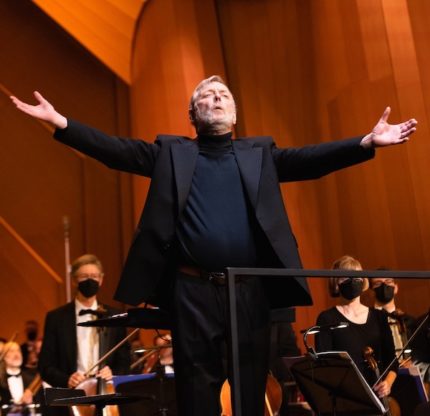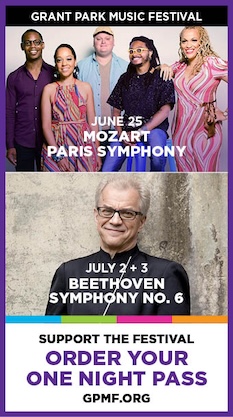Davis closes two decades at Lyric Opera with a stirring Beethoven Ninth

Chicago audiences have had the opportunity to recently fête two local musical icons with performances of Beethoven’s Ninth Symphony.
In February the Chicago Symphony Orchestra honored longtime CSO chorus director Duain Wolfe in his swan-song assignment preparing the Ninth. And Friday night Lyric Opera of Chicago commemorated Sir Andrew Davis’s 21-year tenure as music director. In those two decades, the British conductor led 700 performances of 61 operas by 21 different composers to life on the Civic Opera House stage. Adding to the festal atmosphere was the fact that Beethoven’s Ninth was being performed on the Lyric stage for the first time.
The concert opened with the premiere of A Seed of Joy, a choral piece by Ed Frazier Davis, the conductor’s son. This a cappella choral prelude was designed to segue organically into the initial open fifth of the symphony’s first movement. The text comes from a poem Charles Anthony Silvestri wrote for this occasion, which celebrates the joy that Andrew Davis has brought people through his music-making while also presaging the famous Schiller hymn of brotherhood in the symphony’s finale.
A Seed of Joy begins with the same open fifth (A–E) as Beethoven’s Ninth, sung by the tenors and basses. Mirroring the symphony’s opening growth from nothing, the melodic and harmonic material develops out of this simple sonority as layers are added. The large forces of the Lyric Chorus were perhaps not the best ensemble to premiere this piece, which would have better suited a leaner-toned chamber choir. The vibrato, particularly of the sopranos and altos, too often made the close harmonies impossible to distinguish. After a while, the increasingly thick chords just sounded like noise. While one sensed glimmers of interesting ideas trying to come through the morass, the congested textures made it impossible to make an adequate assessment of the piece.
The attacca segue between A Seed of Joy and the opening of the symphony may have been interesting in theory, but in execution, the chorus had fallen slightly in pitch, which seemed to catch the orchestra off guard. Perhaps the idea that this symphony comes out of nothing would have been better served by a more prolonged silence beforehand to set the stage. Nonetheless, the orchestra bloomed out from the opening sonority in nicely tiered dynamics, arriving at a golden-hued sound that matched the woodwork flanking the stage walls behind them.
Throughout, Davis led the Lyric Opera Orchestra in a rendition that felt fresh and exciting. Given that the orchestra is accustomed to accompanying operas instead of playing titans of the symphonic repertoire day in and day out, this performance seemed hardly phoned in but sizzled with excitement and tension. However, this also meant that there were a couple moments where the ensemble could have been tighter.
For instance, the beefed-up string section sometimes overwhelmed the texture, covering the winds in the first movement, and the falling fourths were a bit tentative at first. The galloping main theme of the Molto vivace was razor sharp, though the articulation in the brass during the pianissimo repeated notes could have been cleaner and sometimes lagged behind the rest of the orchestra.
The orchestra seemed to come into its own in the third movement. The Adagio was appropriately reverent, with Davis bringing a Straussian quality to the sound. The accompanimental string pizzicati were especially delicate, and the winds were allowed to enjoy their place of greater prominence.
In the symphony-within-a-symphony finale, the operatic recitative in the lower strings was poignant. One could sense that their familiarity with the operatic genre informed their interpretation, as it actually sounded like a voice relaying a story. The following opening statement of the “Ode to Joy” melody was beautifully understated as the whole audience held their breath in expectation of what was to come.

Bass-baritone Eric Owens was commanding in his opening invocation, if a bit labored in the high notes. However, his diction was impeccable in the opening vocal statement of the “Ode to Joy.” Rounding out the quartet of soloists were tenor Matthew Polenzani and Ryan Opera Center members soprano Mathilda Edge and mezzo-soprano Kathleen Felty. Their voices complemented each other well, though it was clear that Polenzani and Owens were the experienced veterans of the four.
Polenzani’s focused tenor cut through the texture like a blade, particularly in the Turkish March, which he sang with stylish detached articulation. Unfortunately, Edge got lost during the intricate penultimate quartet and had to drop out for the rest of that section. This left her a bit shaken for the final quartet cadenza, though she executed the devilish final rising line with aplomb. Felty was solid as a rock, though sometimes overpowered by Polenzani’s voice.
The Lyric Chorus was most certainly in its element here. One couldn’t help but be moved by the choir’s stirring entrance, though the continued requirement of face masks among the chorus dulled the impact slightly. Nevertheless, their amassed operatic voices propelled over the orchestra, while the high declamatory singing, especially taxing for the sopranos, never sounded strained. When the tenors and basses sang in unison with the low brass, they achieved a powerful yet blended tone that epitomized the brotherhood of which Schiller’s famous ode speaks.
Davis’ conducting was calm and assured throughout, bringing operatic drama to a few key moments. Sometimes he appeared to be too attached to the score, but acting assistant concertmaster Heather Wittels helped to convey shape and articulation to her colleagues.
Rough edges apart, there was nothing overwrought or hackneyed about this performance of one of the most familiar works of the symphonic repertoire. Davis was visibly moved afterwards as the audience showed their appreciation for the consistently high musical standard he has brought to the Civic Opera House with four well-deserved ovations.
Sir Andrew Davis will conduct Humperdinck’s Hänsel und Gretel at Lyric Opera in January 2023. lyricopera.org
Posted in Performances


Posted Apr 09, 2022 at 10:09 pm by Richard Eastline
Sorry, Kate, but my take on the Beethoven 9th differs. I fully agree with Sir Andrew’s proven capabilities for delivering satisfying performances of non-operatic scores (recall his long career ranging from the Toronto Symphony to the BBC proms).
Bigger isn’t always better. Beefing up the opera-size orchestra of around 50 players by almost 50% and doubling the chorus size to more than a hundred certainly helped fill Lyric’s huge stage—but at a cost of clarity and accuracy. The augmented chorus delivered the loudest vocal parts one could ask for but to the point where too many passages seemed to be screamed rather than sung.
Surely this was likely the most fortissimo production of the 9th heard in Chicago, but unnecessary inasmuch as the every-day size of Lyric’s orchestra and chorus would have nicely matched the numbers of the performing ensembles Beethoven had at his disposal back then.